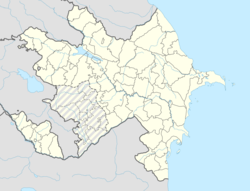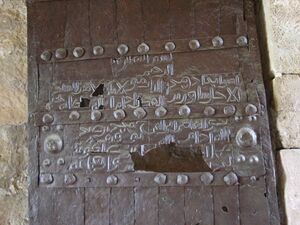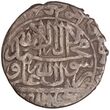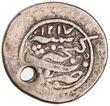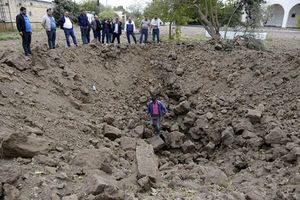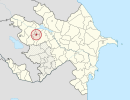گنجه Ganja
گنجه
Gəncə Ganja | |
|---|---|
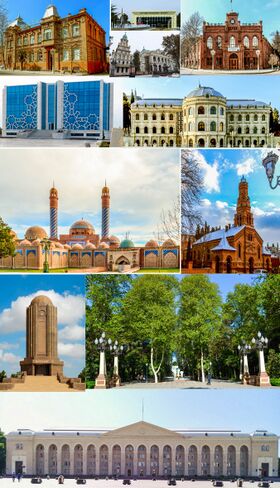 أعلى اليسار: المسجد الجامع، أعلى اليمين: ضريح نظامي، ثاني يسار: المجلس الوطني الأذربيجاني، ثاني يمين: متحف گنجه الأثري، ثالث يسار: منتزه خان باقي، ثالث أعلى اليمين: مبنى مدينة گنجه، ثالث أسفل يمين: مركز مؤتمرات گنجه، أسفل اليسار: شارع جواد خان، أسفل يمين: أكاديمية گنجه الحكومية للعلوم | |
| الإحداثيات: 40°40′58″N 46°21′38″E / 40.68278°N 46.36056°E | |
| البلد | |
| الحكومة | |
| • Mayor | إلمار ولييڤ |
| المساحة | |
| • الإجمالي | 110 كم² (40 ميل²) |
| المنسوب | 408 m (1٬339 ft) |
| التعداد | |
| • الإجمالي | 335٬600 |
| • الكثافة | 3٬100/km2 (7٬900/sq mi) |
| • Population Rank in Azerbaijan | 3rd |
| صفة المواطن | Ganjaly (Gəncəli) |
| منطقة التوقيت | UTC+4 (AZT) |
| لوحة السيارة | 20 AZ |
| الموقع الإلكتروني | ganja-ih |
گنجه ( Ganja ؛ /ˈɡændʒə/؛ آذربيجاني: Gəncə [ɟænˈdʒæ] (![]() استمع)) هي ثالث أكبر مدينة في أذربيجان بتعداد نحو 335,600 نسمة.[2][3][4] The city has been a historic and cultural center throughout most of its existence. It was the capital of the Ganja Khanate until 1804; after Qajar Iran ceded it to the Russian Empire following the Treaty of Gulistan in 1813, it became part of the administrative divisions of the Georgia Governorate, Georgia-Imeretia Governorate, Tiflis Governorate، ومحافظة إليزاڤتپول في عهد الامبراطورية الروسية.[5][6][7] وقد استعادت المدينة اسمها الأصلي—گنجه—منذ 1920 أثناء الجزء الأول من ضمها إلى الاتحاد السوڤيتي. إلا أن اسمها تغير مرة أخرى في 1935 إلى كيروڤ أباد (روسية: Кировабад؛ Kirovabad) واحتفظت بذلك الاسم طوال الفترة السوڤيتية الثانية من 1935. وأخيراً في 1989، أثناء پرسترويكا، استعادت المدينة اسمها الأصلي.
استمع)) هي ثالث أكبر مدينة في أذربيجان بتعداد نحو 335,600 نسمة.[2][3][4] The city has been a historic and cultural center throughout most of its existence. It was the capital of the Ganja Khanate until 1804; after Qajar Iran ceded it to the Russian Empire following the Treaty of Gulistan in 1813, it became part of the administrative divisions of the Georgia Governorate, Georgia-Imeretia Governorate, Tiflis Governorate، ومحافظة إليزاڤتپول في عهد الامبراطورية الروسية.[5][6][7] وقد استعادت المدينة اسمها الأصلي—گنجه—منذ 1920 أثناء الجزء الأول من ضمها إلى الاتحاد السوڤيتي. إلا أن اسمها تغير مرة أخرى في 1935 إلى كيروڤ أباد (روسية: Кировабад؛ Kirovabad) واحتفظت بذلك الاسم طوال الفترة السوڤيتية الثانية من 1935. وأخيراً في 1989، أثناء پرسترويكا، استعادت المدينة اسمها الأصلي.
أصل الاسم
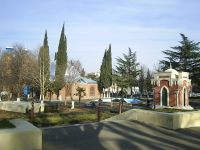
The name Ganja derives from the Persian word ganj (الفارسية المتوسطة: ganza), meaning "treasure" or "treasury".[8] The city was renamed Yelisavetpol (روسية: Елизаветпо́ль, النطق Yelizavetpól'; النطق الروسي: [jɪlʲɪzəvʲɪtˈpolʲ]) during the Russian Empire period.[8] After its incorporation into the Soviet Union it was initially renamed back to Ganja (Gyandzha), but in 1935 the name was changed again to Kirovabad (روسية: Кироваба́д, النطق Kirovabád; النطق الروسي: [kʲɪrəvɐˈbat]), a name which the city retained throughout most of the rest of the Soviet period.[8] In 1989, during perestroika, the city regained its original name of Ganja (آذربيجاني: Gəncə), which is known as Gyandzha (Гянджа, [ɡʲɪnˈdʑa]) in Russian, Gandzak (Գանձակ) in Armenian, and Ganjeh (گنجه) in Persian.
التاريخ
Feudal era
According to medieval Arabic sources, the city of Ganja was founded in 859–60 by Muhammad ibn Khalid ibn Yazid ibn Mazyad, the Arab governor of the region during the reign of the caliph Al-Mutawakkil, and so-called because of a treasure unearthed there. According to the legend, the Arab governor had a dream where a voice told him that there was a treasure hidden under one of the three hills around the area where he camped. The voice told him to unearth it and use the money to found a city. He did so and informed the caliph about the money and the city. Caliph made Muhammad the hereditary governor of the city on the condition that he would give the money he found to the caliph.[9] The foundation of the city by Arabs is confirmed by the medieval Armenian historian Movses Kaghankatvatsi, who mentions that the city of Ganja was founded in 846–47 in the canton of Arshakashen by the son of Khazr Patgos, "a furious and merciless man".[10]
However, the Persian origin of Ganja's name suggests that there was an older pre-Islamic town there.[8] According to some sources, it changed hands between Persians, Khazars and Arabs even in the 7th century.[11] The area in which Ganja is located was known as Arran from the 9th to 12th century; its urban population spoke mainly in the Persian language.[12][13]
Historically an important city of the South Caucasus, Ganja has been part of the Sassanid Empire, Great Seljuk Empire, Kingdom of Georgia, Atabegs of Azerbaijan, Khwarezmid Empire, Il-Khans,[14] Timurids,[15] Qara Qoyunlu,[16] Ak Koyunlu,[17][18] the Safavid, the Afsharid, the Zand and the Qajar empires of Persia/Iran. Prior to the Iranian Zand and Qajar rule, following Nader Shah's death, it was ruled locally for a few decades by the khans/dukes of the Ganja Khanate, who themselves were subordinate to the central rule in mainland Iran and were a branch of the Iranian Qajar family.[19][20] Ganja is also the birthplace of the famous Persian poet Nizami Ganjavi.
The people of Ganja experienced a temporary cultural decline after an earthquake in 1139, when the city was taken by king Demetrius I of Georgia and its gates taken as trophies which is still kept in Georgia, and again after the Mongol invasion in 1231. The city was revived after the Safavids came to power in 1501, and incorporated all of Azerbaijan and beyond into their territories. The city came under brief occupation by the Ottomans between 1578–1606 and 1723–1735 during the prolonged Ottoman-Persian Wars, but nevertheless stayed under intermittent Iranian suzerainty from the earliest 16th century up to the course of the 19th century, when it was forcefully ceded to neighbouring Imperial Russia.[21]
16th–19th centuries and Iran's ceding to Russia
For a short period, Ganja was renamed Abbasabad by Shah Abbas after war against the Ottomans. He built a new city 8 كيلومتر (5 ميل) to the southwest of the old one, but the name changed back to Ganja during the time.[22] During the Safavid rule, it was the capital of the Karabakh province. In 1747, Ganja became the center of the Ganja Khanate for a few decades following the death of Nader Shah, until the advent of the Iranian Zand and Qajar dynasties. The khans/dukes who de facto self-ruled the khanate, were subordinate to the central rule in mainland Iran and were from a branch of the Iranian Qajar family.[19][20]

From the late 18th century, Russia actively started to increase its enroachments into Iranian and Turkish territory to the south. Following the annexation of eastern Georgia in 1801, Russia was now keen to conquer the rest of the Iranian possessions in the Caucasus. Russian expansion into the South Caucasus met particularly strong opposition in Ganja. In 1804, the Russians, led by General Pavel Tsitsianov, invaded and sacked Ganja, sparking the Russo-Persian War of 1804–1813.[23] Some western sources assert that "the capture of the city was followed by a massacre of up to 3,000 inhabitants of Ganja by the Russians".[24] They also claim that "500 of them were slaughtered in a mosque where they had taken refuge, after an Armenian apprised the Russians that there might have been 'Daghestani robbers' among them".[25]
With their military superiority, the Russians were victorious in the Russo-Persian War of 1804–1813. By the Treaty of Gulistan that followed, Iran was forced to cede the Ganja Khanate to Russia.[21] The Iranians briefly managed to oust the Russians from Ganja during the 1826 offensive during the Russo-Persian War of 1826–1828, but the resulting Treaty of Turkmenchay made its inclusion into the Russian Empire permanent.[26] It was renamed Yelizavetpol (Елизаветполь) after the wife of Alexander I of Russia, Elizabeth, and in 1840 became the capital of the Elizavetpol uezd and later in 1868, the Elizavetpol Governorate.[27] The Russian name of the city was rejected by the local Azerbaijanis who continued call it Ganja.[28]
20th century
Ganja—known then as Yelisavetpol—was one of the main sites of the Armenian–Tatar massacres of 1905–07. In 1918, Ganja became the temporary capital of the Azerbaijan Democratic Republic, at which point it was renamed Ganja again, until Baku was recaptured from the British-backed Centrocaspian Dictatorship. In April 1920, the Red Army occupied Azerbaijan. In May 1920, Ganja was the scene of an abortive anti-Soviet rebellion, during which the city was heavily damaged by fighting between the insurgents and the Red Army.[29] In 1935, Joseph Stalin renamed the city Kirovabad after Sergei Kirov.[30] In 1991, Azerbaijan re-established its independence, and the ancient name of the city was given back. For many years the 104th Guards Airborne Division of the Soviet Airborne Troops was based in the town.[31]
اشتباكات ناگورنو قرةباخ
في 4 أكتوبر 2020، أعلنت وزارة الدفاع الأذربيجانية، عن تعرض غنجة، ثاني أكبر مدن أذربيجان للقصف من قبل القوات الأرمينية. يأتي ذلك بعدما أعلنت القوات الأرمينية تدمير مطار عسكري في غنجة. وأضافت أن المواقع العسكرية في مدن كبيرة داخل أذربيجان أصبحت الآن أهدافاً، وحثّت السكان على مغادرتها تفادياً للخسائر.[32]
من جانبه نفى مساعد رئيس أذربيجان تدمير منشآت عسكرية في غنجه، لكنهّ أكد تعرّض المدينة لقصف صاروخيّ، أدّى إلى مقتل شخص وإصابة 4 مدنيين على الأقل. وقال المساعد للرئيس الأذربيجاني إلهام علييڤ إن بلاده ستدمر أهدافاً عسكرية في أرمينيا تطلق يريڤان منها النار على مدن أذربيجانية.
ونددت تركيا بما وصفته بهجوم أرمينيا على مدينة غنجة الأذربيجانية، وأكدت مجدداً دعمها لحق أذربيجان في الدفاع عن نفسها داخل حدودها المعترف بها دولياً. وقالت وزارة الخارجية التركية "هجمات أرمينيا التي استهدفت مدنيين في غنجه... إظهار جديد لسلوك أرمينيا المخالف للقانون. نحن نستنكر هذه الهجمات".
وفيما تتواصل المعارك العنيفة بين آذربيجان وأرمينيا على معظم خط الجبهة في ناگورنو قرةباخ، أعلن الرئيس الأذربيجاني إلهام علييف أن قواته سيطرت على 7 قرى على خط التماس مع الإقليم.
من جانب آخر، قال رئيس الوزراء الأرميني نيكول باشينيان، إنّ بلاده تواجه " لحظات مصيرية"، داعياً الأرمينيّين إلى توحيد الصفوف.
وفي اليوم نفسه استهدفت ضربات جديدة أعقبتها انفجارات، إستپاناكرت، كبرى مدن منطقة ناگورنو قرةباخ. ودوّت صفارات الإنذار في المدينة قبل أن تتعاقب الانفجارات. وأشارت السلطات الأذربيجانية، من جانبها، إلى أنها اتخذت إجراءات انتقامية بعد إطلاق الانفصاليين الأرمينيين قذائف انطلاقاً من إستپاناكرت.
وشهدت إستپاناكرت في الأيام الأخيرة عدة ضربات من هذا النوع، مما أجبر السكان على الاحتماء في أقبية وملاجئ. وقُطعت الكهرباء من ليلة السبت إلى الأحد في المدينة. وذكرت وزارة الخارجية المحلية أن القوات الأذربيجانية استهدفت مبنى الشبكة الكهربائية الليلة الماضية.
وظل الدمار محدوداً في وسط المدينة، وأشارت وزارة الدفاع الأذربيجانية، من جانبها، إلى أن "القوات الأرمينية تطلق قذائف على بلدتي ترتر وهوراديز في منطقة فيزولي انطلاقاً من خانكندي"، وهي التسمية الأذربيجانية لإستپاناكرت. وأضافت "الجيش الأذربيجاني اتخذ إجراءات انتقامية مناسبة ضد العدو".
وكانت وزارة الدفاع الأرمينية أعلنت في اليوم السابق أن أذربيجان شنت هجوماً واسعاً، حيث تدور معارك عنيفة بين الجانبين على جبهات عدة، كذلك أعلنت أرمينيا استعدادها لوقف إطلاق النار مع أذربيجان ضمن وسطاء.
الجغرافيا
المناخ
| بيانات المناخ لـ گنجه | |||||||||||||
|---|---|---|---|---|---|---|---|---|---|---|---|---|---|
| الشهر | ينا | فب | مار | أبر | ماي | يون | يول | أغس | سبت | أكت | نوف | ديس | السنة |
| متوسط القصوى اليومية °س (°ف) | 6.5 (43.7) |
6.8 (44.2) |
11.9 (53.4) |
19.2 (66.6) |
23.4 (74.1) |
27.9 (82.2) |
31.4 (88.5) |
29.9 (85.8) |
26.0 (78.8) |
19.3 (66.7) |
12.6 (54.7) |
8.3 (46.9) |
18.6 (65.5) |
| متوسط الدنيا اليومية °س (°ف) | −2.3 (27.9) |
−1.2 (29.8) |
2.2 (36.0) |
7.7 (45.9) |
12.2 (54.0) |
16.3 (61.3) |
19.5 (67.1) |
18.3 (64.9) |
15.2 (59.4) |
9.2 (48.6) |
4.5 (40.1) |
0.0 (32.0) |
8.5 (47.3) |
| متوسط تساقط الأمطار mm (inches) | 10 (0.4) |
17 (0.7) |
32 (1.3) |
30 (1.2) |
42 (1.7) |
46 (1.8) |
23 (0.9) |
18 (0.7) |
16 (0.6) |
32 (1.3) |
14 (0.6) |
18 (0.7) |
298 (11.9) |
| Average precipitation days | 4 | 5 | 5 | 6 | 9 | 7 | 3 | 4 | 3 | 6 | 3 | 4 | 59 |
| Source: منظمة الأرصاد الجوية الدولية (UN) [33] | |||||||||||||
التقسيمات الادارية
تنقسم گنجه إلى:
- مقاطعة كپز، ويسكنها نحو 160,000 نسمة
- مقاطعة نظامي، ويسكنها نحو 140,000 نسمة
الديمغرافيا
| السنة | آذريون | % | أرمن | % | روس | % | آخرون 1 | % | الإجمالي |
|---|---|---|---|---|---|---|---|---|---|
| 1886 [34] | 20,294 | ||||||||
| 1892[35] | 25,758 | ||||||||
| 1897 [36] | 33,625 | ||||||||
| 1926[34] | 57,339 | ||||||||
| 1939 [37] | 98,494 | ||||||||
| 1959 [38] | 116,122 | ||||||||
| 1970[39] | 189,512 | ||||||||
| 1979[40] | 231,066 | ||||||||
| 1988/1989 [41] | 278,006 [42] | ||||||||
| 1999 [43] | 299,342 | ||||||||
| 2009[44] | 313,249 | ||||||||
| 1 الجورجيون، اليهود، الاوكرانيون، إلخ. 2قُبيل حرب ناگورنو-قرةباخt [45] | |||||||||
الجالية الأرمنية التاريخية
مؤسس الأسرة الهتومية، اوشين من لامپرون كان نخرار أرمني وسيد القلعة بالقرب من گنجه الذي فر إلى قيليقيا في 1075 أثناء الغزو السلجوقي لأرمنيا.[46]
المباني والمعالم والمتاحف
في القرن 11، قام حداد محلي اسمه ابراهيم بشَغل بوابات گنجه الشهيرة.[47]
- ضريح نظامي، بُني تكريماً للشاعر نظامي گنجوي, stands just outside the city of Ganja, Azerbaijan. It attracts nearly 35000 visitors per year.[48]
- Shah Abbas Caravanserai, At present it is in use of the Ganja State Humanitarian college
- جامع شاه عباس, the mosque was under construction in 1606 under the project of Sheikh Baahaddin Mahammad Amilin mosque and currently is biggest mosque of the city.
- Khan Bagi. The 17th century built garden
- Chokak Bath, center of the applied art
- The European bath of 19th century.
- الكنيسة الأرمنية. Built in the 17th century.
- Caucasian Albanian Church. Built in the 15th century and currently, it is in use of the Ganja State Philharmonic Chamber.
- Russian Orthodox church.
التعليم
تضم گنجه أربع معاهد كبيرة للدراسة الجامعية:
- جامعة گنجه الحكومية
- Azerbaijan State Agricultural Academy
- Azerbaijan Technological University
- Azerbaijan Teachers Institute، فرع گنجه
المواصلات
النقل الجوي
مطار گنجه الدولي هو المطار الوحيد في المدينة.[49] يتصل الممطار بوسط المدينة عن طريق الحافلات. هناك رحلات محلية إلى باكو وأخرى دولية إلى روسيا، أوكرانيا، وتركيا.
السكك الحديدية
تقع گنجه على واحداً من خطوط السكك الحديدية الرئيسية في أذربيجان، الذي يمتد من الشرق للغرب ليصل العاصمة باكو ببقية البلاد. يوفر خط السكك الحديدية خدمات النقل البشرية ونقل السلع والبضائع مثل النفط والحصى.
اللغات
يتحدث معظم سكان گنجه باللغة الأذربيجانية.
الرياضات
للمدينة فريق كرة قدم محترف واحد ويعتبر من أندية الدرجة الأولى الأذربيجانية - FC Kəpəz - الذي يلعب حالياً في الدوري الأذربيجاني الممتاز.[50] حصل الفريق ثلاثة ألقاب في الدوري الأذربيجاني الممتاز وثلاثة كؤوس.
العلاقات الدولية
البلدات التوأم - المدن الشقيقة
| المدينة | البلد |
|---|---|
| أنقرة | |
| اولوموتس | |
| دربند | |
| روستاڤي | |
| نوارك، نيوجرزي | |
| إزمير | |
| موسكو | |
| دنيپروپتروڤسك | |
| قارص | |
| دوشانبه |
انظر أيضاً
أشهر أبنائها
- طغرل أصغروڤ - Olympic champion wrestler (2012).
- Albert Azaryan - 3-time Olympic champion (1956, 1960), four-time world champion (1954, 1958), 2-time European champion (1955), 11-time champion of the USSR (1952–1962 ) by Gymnastics, President of the Gymnastics Federation of Armenia.
- Hakob Hakobyan - Soviet Armenian writer, the national poet of Armenian SSR and Georgian SSR.
- Karo Halabyan (1897–1959) - architect, academician, president, vice-president of the Academy of Architecture of the USSR, the Secretary of the Union of Architects of the USSR (1932–1950).
- Abraham Alikhanov - Armenian Soviet physicist, Academy USSR.
- Yuri Harutyunyan (born March 25, 1944) - Soviet Armenian composer, People's Artist of USSR (1970) .
- Vardan Areveltsi (Vardan the Great) - Armenian historian, geographer, philosopher, educator and social activist church of the 13th century.
- Vorobyev, Vsevolod Mikhailovich - outstanding Soviet and Ukrainian pianist and teacher.
- Gandzaketsi, Kirakos - Armenian historian of the 13th century., The author of "History of Armenia".
- Gosh, Mkhitar - Armenian philosopher, literary and social activist, theologian and priest 12th - 13th centuries.[52]
- Suren Kazumian - Armenian and Russian businessman [53]
- Kevorkov, Sergei Nikitich - Armenian Soviet ballet dancer and choreographer, Honored Artist of the RSFSR (1936), Honored Artist of Azerbaijan SSR (1943).
- Martirosyan, Vilen Arutyunovich - Armenian Soviet soldier and statesman, Major-General Armed Forces of Ukraine People's Deputy of the USSR (from Rivne constituency, 1989–1991), Chairman of the "Fatherland" (Ukraine).
- Askanaz Mravyan - Armenian Soviet state and party leader, secretary of the Communist Party of Armenia (1920–1922).
- Adil Isgandarov — director, actor, People's Artist of USSR (1959).[54]
- Artur Rasizade — Prime Minister of Azerbaijan (1996–2003 and since 2003)).[55]
- Elbrus Allahverdiyev — National Hero of Azerbaijan.[56]
- Enver Arazov — National Hero of Azerbaijan.[57]
- Eyyub Khanbudagov — chief of the Azerbaijani Extraordinary Commission (Azerbaijani Cheka) (1920–1921).[58]
- Fikret Amirov — composer, People's Artist of USSR (1965), Hero of Socialist Labor.[59]
- Javad Khan — khan of Ganja Khanate (1786–1803).
- Igor Makeyev — National Hero of Azerbaijan.[60]
- Khalil Zeinal — Azerbaijani poet and playwright, Honored Art Worker of Azerbaijan SSR.[61]
- Madat Guliyev — National Hero of Azerbaijan.[62]
- Mahsati Ganjavi — poetess.
- Mammadbaghir Sheikhzamanly — 1st chief of the "Organization to struggle against counterrevolution" of Azerbaijan Democratic Republic (1919).[63]
- Mammadrza Sheikhzamanov — film and theater actor, People's Artist of Azerbaijan SSR (1974).[64]
- Mirza Shafi Vazeh — Azerbaijani poet.[65]
- Murtuz Alasgarov — Speaker of the National Assembly of Azerbaijan (1996–2005).[66]
- Museib Baghirov — Hero of the Soviet Union.[67]
- Nagi Sheikhzamanly — chief of the "Organization to struggle against counterrevolution" of Azerbaijan Democratic Republic (1919–1920).[68]
- Nasib Yusifbeyli — Chairman of the Council of Ministers of the Azerbaijan Democratic Republic (1919–1920).[69]
- Nigar Rafibeyli — writer.
- Nizami Ganjavi — famous poet.
- Parviz Samadov — National Hero of Azerbaijan.[70]
- Rafael Asadov — National Hero of Azerbaijan.[71]
- Surat Huseynov — Prime Minister of Azerbaijan (1993–1994).
- Namiq Sheikhzamanov — surgeon, MD, Ph.D.
- Tamerlan Sheikhzamanov — lawyer-politician, сounsellor in the National Assembly of Azerbaijan Republic.
صور گنجه
- Nizami Ganjavi Monument 2.jpg
الهامش
- ^ "Population of Azerbaijan". stat.gov.az. State Statistics Committee. Retrieved 22 February 2021.
- ^ State Statistical Committee of the Republic of Azerbaijan, Official Publication: Statistical Yearbook of Azerbaijan 2018, Baku
- ^ Azərbaycan Respublikası. — 2. Azərbaycan Respublikasının iqtisadi və inzibati rayonları. — 2.4. Azərbaycan Respublikasının iqtisadi və inzibati rayonlarının ərazisi, əhalisinin sayı və sıxlığı, səhifə 66. // Azərbaycanın əhalisi (statistik bülleten). Müəllifi: Azərbaycan Respublikasının Dövlət Statistika Komitəsi. Buraxılışa məsul şəxs: Rza Allahverdiyev. Bakı — 2015, 134 səhifə.
- ^ Bölmə 2: Demoqrafik göstəricilər, səhifə 89. // Azərbaycanın Statistik Göstəriciləri 2015 (statistik məcmuə). Müəllifi: Azərbaycan Respublikası Dövlət Statistika Komitəsi. Məcmuənin ümumi rəhbəri: Həmid Bağırov; Məcmuənin hazırlanması üçün məsul şəxs: Rafael Süleymanov. Bakı – 2015, 814 səhifə.
- ^ Bournoutian, George (2018). Armenia and Imperial Decline: The Yerevan Province, 1900-1914. Routledge. pp. 6–7.
- ^ Bosworth, C. Edmund (2000). "GANJA". In Yarshater, Ehsan (ed.). Encyclopædia Iranica, Volume X/3: Fruit–Gāvbāzī. London and New York: Routledge & Kegan Paul. pp. 282–283. ISBN 978-0-933273-47-4.
- ^ Tucker, Spencer C., ed. (2019). Middle East Conflicts from Ancient Egypt to the 21st Century: An Encyclopedia and Document Collection. ABC-CLIO. p. 489. ISBN 978-1440853524.
- ^ أ ب ت ث Bosworth, C. Edmund (December 15, 2000). "Ganja". Encyclopædia Iranica. Vol. X, Fasc. 3. pp. 282–283.
- ^ Minorsky, Vladimir. История Ширвана и Дербенда [A History of Shirvan and Derbent] (in الروسية). Archived from the original on 26 September 2007. Retrieved 10 September 2007.
- ^ History of the Caucasian Albanians by Movses Dasxuranci, C.J.F. Dowsett trans. (London 1961), chapter 21.
- ^
 Chisholm, Hugh, ed. (1911). . دائرة المعارف البريطانية. Vol. 9 (eleventh ed.). Cambridge University Press. p. 280.
Chisholm, Hugh, ed. (1911). . دائرة المعارف البريطانية. Vol. 9 (eleventh ed.). Cambridge University Press. p. 280. {{cite encyclopedia}}: Cite has empty unknown parameter:|coauthors=(help) - ^ Rybakov, Rostislav, ed. (1995). История Востока. Восток в средние века [History of the East. East in the Middle Ages] (in الروسية). Vol. 2. ISBN 978-5-02-017711-6.[صفحة مطلوبة]
- ^ Diakonov, Igor (1995). Книга воспоминаний [The Book of Memoirs] (in الروسية). Saint Petersburg: Yevropeyskiy Dom. pp. 730–731. ISBN 978-5-85733-042-5.
- ^ "Iran". Encyclopædia Britannica. 2007. Archived from the original on 19 February 2007. Retrieved 17 March 2007.
- ^ "Timurid Dynasty". Encyclopædia Britannica. 2007. Archived from the original on 2 September 2007. Retrieved 17 March 2007.
- ^ "Kara Koyunlu". Encyclopædia Britannica. 2007. Archived from the original on 29 October 2007. Retrieved 17 March 2007.
- ^ "Ak Koyunlu". Encyclopædia Britannica. 2007. Archived from the original on 30 September 2007. Retrieved 17 March 2007.
- ^ "Ganja's History". Aznet.org. Archived from the original on 29 March 2007. Retrieved 17 March 2007.
- ^ أ ب Swietochowski, Tadeusz (2004). Russian Azerbaijan 1905–1920: The Shaping of National Identity in a Muslim Community. Cambridge, UK: Cambridge University Press. ISBN 0-521-52245-5.[صفحة مطلوبة]
- ^ أ ب "History of Azerbaijan". Encyclopædia Britannica. Archived from the original on 18 November 2008.
- ^ أ ب Dowling, Timothy C. (2014). Russia at War: From the Mongol Conquest to Afghanistan, Chechnya, and Beyond. ABC-CLIO. p. 728. ISBN 978-1-59884-948-6.
- ^ Pashayev, Seyyaf Sednik oqli (2003). "The Monuments of Ganja Khanate of the Period form 1606–1804". gitc.aznet.org. Translated by Remizova, Yelena. Archived from the original on 3 July 2007. Retrieved 16 February 2007.
- ^ Tucker, Spencer C., ed. (2010). A Global Chronology of Conflict: From the Ancient World to the Modern Middle East. ABC-CLIO. p. 1035. ISBN 978-1-85109-672-5.
January 1804. (...) Russo-Persian War. Russian invasion of Persia. (...) In January 1804 Russian forces under General Paul Tsitsianov (Sisianoff) invade Persia and storm the citadel of Ganjeh, beginning the Russo-Persian War (1804-1813).
- ^ Peter Avery; William Bayne Fisher; Gavin Hambly; Charles Melville (25 October 1991). The Cambridge history of Iran: From Nadir Shah to the Islamic Republic. Cambridge University Press. p. 332. ISBN 978-0-521-20095-0.
- ^ Baddeley, John F. (1908). The Russian Conquest of the Caucasus. London: Longmans, Green and Co. p. 67. Citing "Tsitsianoff's report to the Emperor: Akti, ix (supplement), p. 920".
- ^ Timothy C. Dowling (2014). Russia at War: From the Mongol Conquest to Afghanistan, Chechnya, and Beyond. ABC-CLIO. pp. 728–729. ISBN 978-1-59884-948-6.
- ^
- ^ Swietochowski, Tadeusz (2004). Russian Azerbaijan, 1905–1920: The Shaping of a National Identity in a Muslim Community. Cambridge University Press. ISBN 978-0-521-52245-8.[صفحة مطلوبة]
- ^ Charles van der Leeuw (4 July 2000). Azerbaijan: a quest for identity : a short history. Palgrave Macmillan. p. 124. ISBN 978-0-312-21903-1.
- ^ "Gəncənin tarixi..." ganca.net (in الأذربيجانية). Archived from the original on 16 July 2011.
- ^ "31-я гвардейская отдельная воздушно-десантная ордена Кутузова II степени бригада". bratishka.ru (in الروسية). Archived from the original on 29 November 2014. Retrieved 17 November 2014.
- ^ "القوات الأرمينية تدمّر مطاراً عسكرياً في غنجه بأذربيجان". قناة الميادين. 2020-10-04. Retrieved 2020-10-04.
- ^ "World Weather Information Service – Ganja". United Nations. Retrieved 19 January 2011.
- ^ أ ب (بالروسية) Ethno-Caucasus: Азербайджан
- ^ Елисаветополь в Энциклопедическом словаре Брокгауза и Ефрона
- ^ (بالروسية) Демокоп Weekly г. Елисаветполь
- ^ (بالروسية) Ethno-Caucasus: КИРОВАБАДСКИЙ ГОРСОВЕТ (1939 г.)
- ^ (بالروسية) Ethno-Caucasus: КИРОВАБАДСКИЙ ГОРСОВЕТ (1959 г.)
- ^ (بالروسية) Ethno-Caucasus: КИРОВАБАДСКИЙ ГОРСОВЕТ (1970 г.)
- ^ (بالروسية) Ethno-Caucasus: КИРОВАБАДСКИЙ ГОРСОВЕТ (1979 г.)
- ^ (بالروسية) Численность армянского населения в крупных городах и районах АзССР
- ^ (بالروسية) Всесоюзная перепись населения 1989 г. Численность городского населения союзных республик, их территориальных единиц, городских поселений и городских районов по полу
- ^ Ethnic composition of Azerbaijan 1999
- ^ Ethnic composition of Azerbaijan 2009
- ^ (بالروسية) Численность армянского населения в крупных городах и районах АзССР
- ^ M. Setton, Kenneth (2006-03-24). "XVIII: The Kingdom of Cilician Armenia". The later Crusades, 1189-1311 (A History of the Crusades, volume, II). Madison, Wisconsin: University of Wisconsin Press. p. 633. ISBN 978-0-299-04844-0.
{{cite book}}: More than one of|author=and|last=specified (help); Unknown parameter|coauthors=ignored (|author=suggested) (help) - ^ Ministry of Culture and Tourism of the Republic of Azerbaijan: Ganja's History
- ^ Nizami Gəncəvinin məqbərəsi uça bilər (أذربيجاني)
- ^ Gəncə Beynəlxalq hava limanının açılış mərasimi (أذربيجاني)
- ^ Гянджа сегодня (بالروسية)
- ^ Cities in the Czech Republic and Azerbaijan to Become Sister
- ^ History of the Middle Ages. Europe and Asia. Badak AN, Voynich IE, Volchek NM et al Minsk. "Harvest." In 2000. p. 275.
- ^ 20biznes% 20elita% 20Rossii.pdf Armenian business elite of Russia
- ^ "Искендеров Адиль Рза оглы". Great Soviet Encyclopedia.
- ^ "РАСИЗАДЕ Артур - БД "Лабиринт"" (in الروسية). База данных "Лабиринт.
- ^ "Allahverdiyev Elbrus Haji oglu". milliqahraman.az.
- ^ "Arazov Enver Talish oglu". milliqahraman.az.
- ^ "Khanbudagov Eyyub Shirin". Minister of National Security Azerbaijan Republic.
- ^ "Амиров Фикрет Мешади Джамиль оглы". Great Soviet Encyclopedia.
- ^ "Makeyev Igor Vladimirovich". milliqahraman.az.
- ^ "Халил Зейнал". Great Soviet Encyclopedia.
- ^ "Guliyev Madat Gazanfar oglu". milliqahraman.az.
- ^ "Sheikhzamanly Mamedbaghir Salekh: June–August, 1919". Minister of National Security Azerbaijan Republic.
- ^ "Шейхзаманов Мамедрза Иса оглу". kino-teatr.ru.
- ^ "Вазех". Great Soviet Encyclopedia.
- ^ "АЛЕСКЕРОВ Муртуз - БД "Лабиринт"" (in الروسية). База данных "Лабиринт.
- ^ "Багиров Мусеиб Багирович" (in الروسية). Heroes of the country.
- ^ "Sheikhzamanly Naghi Salekh". Minister of National Security Azerbaijan Republic.
- ^ "Усуббеков (Юсифбейли) Насиб бек Юсиф оглы". Биографический словарь «Политические деятели России. 1917».
- ^ "Samadov Parviz Abdulahad oglu". milliqahraman.az.
- ^ "Asadov Rafael Avaz oglu". milliqahraman.az.
وصلات خارجية
- CS1 uses الروسية-language script (ru)
- CS1 الروسية-language sources (ru)
- مقالات المعرفة المحتوية على معلومات من دائرة المعارف البريطانية طبعة 1911
- مقالات بالمعرفة بحاجة لذكر رقم الصفحة بالمصدر from October 2020
- CS1 الأذربيجانية-language sources (az)
- CS1 errors: unsupported parameter
- CS1 errors: redundant parameter
- Articles with hatnote templates targeting a nonexistent page
- Missing redirects
- Short description is different from Wikidata
- Pages using gadget WikiMiniAtlas
- Articles containing آذربيجاني-language text
- Pages using Lang-xx templates
- Pages with plain IPA
- Articles containing روسية-language text
- Articles containing Middle Persian-language text
- Articles containing أرمنية-language text
- Articles containing فارسية-language text
- گنجه
- أماكن مأهولة في أذربيجان
- مقاطعات أذربيجان
- أماكن مأهولة تأسست في القرن التاسع

